From lowly algae to the mighty sequoia, plants are at the heart of most of Earth’s ecosystems. Using photosynthesis, they gather energy from sunlight and produce the oxygen essential for animals, fungi, plants themselves, and many microbes. They provide most of our food, shelter, and medicines. Land plants first appeared around 450 million years ago during the Ordovician period, and have become increasingly complex since then.
There are two main types of plants. Vascular plants use a system of tissues called xylem and phloem – to transport water and nutrients throughout the plant. Non-vascular plants, by contrast, have no xylem or phloem, and cannot regulate their water content.
Many of the plants seen in this exhibit represent some of the most ancient plant lineages alive today. Long before grasses or wildflowers evolved, these primitive plants dominated the landscape, sometimes growing to enormous size.

The mosses or bryophytes are small non-vascular plants that absorb water and nutrients directly through their leaves. They do not have a root system, but anchor themselves through thread-like fibers called rhizoids. Mosses reproduce by shedding spores. Although the bryophyte fossil record is sparse due to their fragility, recognizable moss fossils are known from the Permian period and possibly the Carboniferous as well.
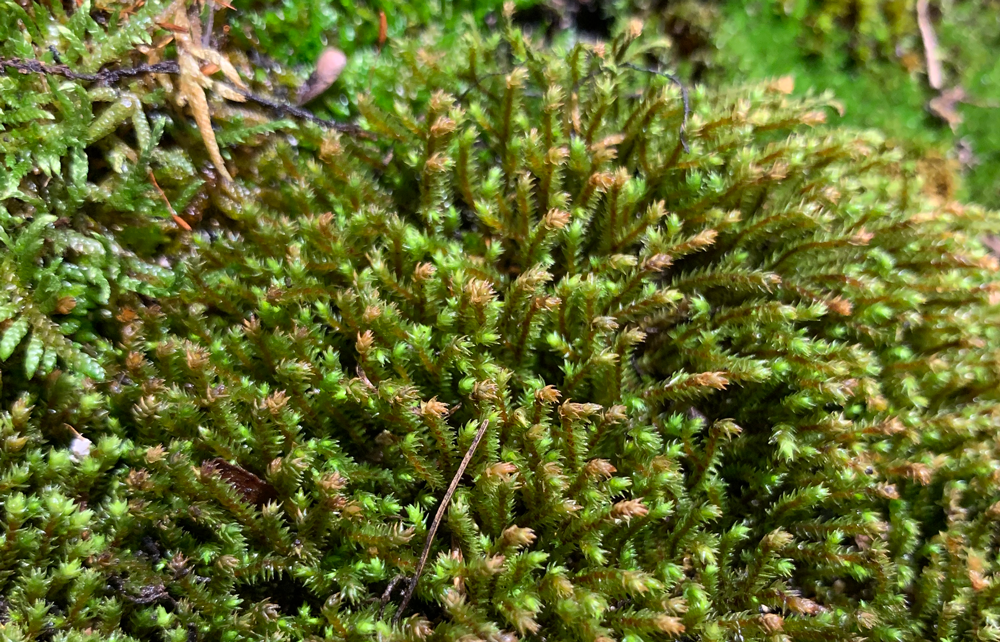
Living moss on exhibit at the Museum of the Earth, Ithaca, New York. Photo by Jonathan R. Hendricks.

The lycopods or lycophytes are one of the oldest lineages of living vascular plants. They first appeared in the Silurian period (425 million years ago), and became extremely diverse by the late Carboniferous period (323-298 million years ago) and some species grew as trees more than 100 feet tall. Today, lycopods comprise nearly 1300 living species, including the clubmosses, spikemosses, and quillworts. They are small, slow-growing plants that colonize forest floors and wetlands, and reproduce by shedding spores.
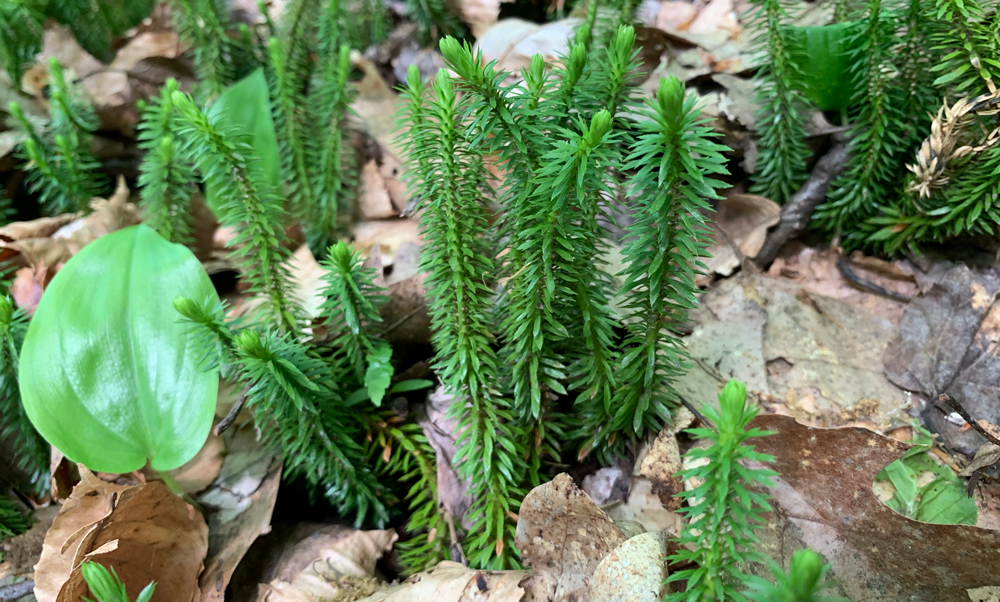
The clubmoss Huperzia lucidula, a type of lycopod, growing near Dryden, New York. Photo by Jonathan R. Hendricks.
Examples of fossil horsetails
Root of fossil lycopod Stigmaria sp. from the Carboniferous of Illinois. Specimen is from the Cornell University Paleobotanical Collection (CUPC), Ithaca, New York. Length of specimen is approximately 18.5 cm.
Conservation connection
Clubmosses were once harvested extensively for use in Christmas wreaths and for their spores. Lycopod spores are flammable and can be used to make flash powder, originally used in the late 1800s for special effects as well as in flash photography. Clubmosses grow extremely slowly, with some species taking as many as 20 years to develop from a spore to a fully mature plant. As a result, many North American clubmosses were decimated from excessive harvesting and are rare in the wild today. Several states, including New York and Indiana, now have laws protecting certain clubmoss species from collection.
Polypodiophyta
The ferns include several major groups. True ferns have feathery leaves and produce spore capsules from a single cell. Other fern groups have a wide diversity of forms, including horsetails and whisk ferns, and produce spores from a group of cells on their leaves.

Horsetails are the only living members of the Equisetaceae, a spore-bearing family of vascular plants that was extremely diverse during the late Paleozoic era. Some members of this group, like the tree-size Calamites, grew to enormous size and dominated Carboniferous forests along with the lycopods. Modern horsetails, the genus Equisetum, first appeared during the late Jurassic (165 million years ago). There are about 20 living species and they can be found on every continent except Antarctica. The plant’s common name refers to its resemblance to a horse’s tail.

A horsetail (Equisetum sp.) growing in California. Photo by Jonathan R. Hendricks.
Examples of fossil horsetails
Stem of the fossil horsetail Calamites sp. from the Carboniferous of Illinois. Specimen is from the Cornell University Paleobotanical Collection (CUPC), Ithaca, New York. Length of specimen is approximately 14 cm.
Fossil rhizome (underground stem) of the horsetail Calamites sp. from the Carboniferous of Illinois. Specimen is from the Cornell University Paleobotanical Collection (CUPC), Ithaca, New York. Length of specimen is approximately 21.5 cm.
Fossil leaves of the horsetail Annularia stellata preserved in a concretion from the Pennsylvanian of the Mazon Creek area of northeastern Illinois (PRI T-1762). Specimen is from the teaching collection of the Paleontological Research Institution, Ithaca, New York. Length of surrounding rock is approximately 15 cm.

True ferns (the plants we know most commonly as “ferns”) are an extremely diverse group of vascular plants that first appear in the fossil record during the Devonian period (380 million years ago). However, many of the species we know today did not appear until the Cretaceous period (145 million years ago), when a major radiation occurred. Today, there are around 9000 fern species. Ferns have complex leaves and reproduce via spores, with no flowers or seeds. They can be found in a wide variety of habitats, from alpine and woodland environments to rainforests, ponds and lakes, and even deserts.
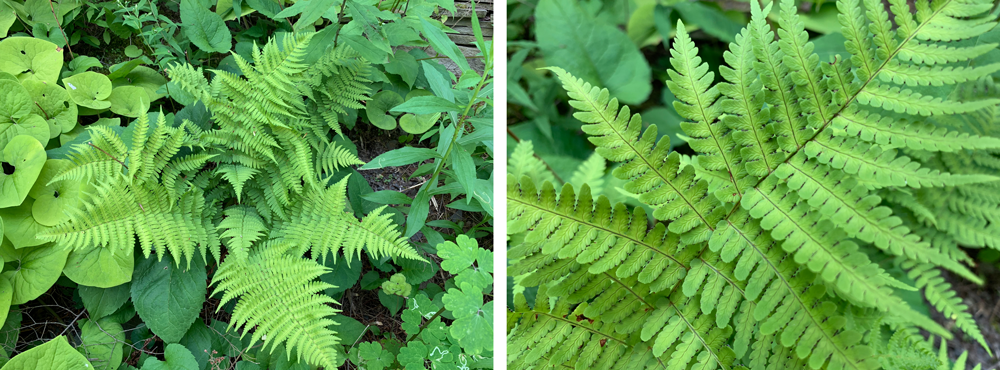
A marginal wood fern (Dryopteris marginalis) growing on the property of the Paleontological Research Institution, Ithaca, New York.
Stem of the modern tree fern Dicksonia sp. from Australia. Specimen is from the Cornell Unversity Paleobotanical Collection (CUPC), Ithaca, New York. Length of specimen is approximately 14.5 cm.
Section of fossil tree fern Tempskya wesselli from the Cretaceous of Idaho. Specimen is from the paleobotanical collections of the School of Integrative Plant Sciences at Cornell University, Ithaca, New York. Longest dimension of specimen is approximately 8.5 cm.

Seed plants evolved during the Devonian period around 370 million years ago. They enclose their embryos in a protective outer covering - a seed. Seeds were a major evolutionary development for plants, allowing them to disperse farther, survive harsh environments, and provide nutrients to the young plant.
The “naked seed” plants, also called gymnosperms, were the first type of seed plants. Their seeds are often enclosed in cones. Gymnosperms rapidly dominated the landscape after they evolved, replacing forests once filled with giant lycopods. Seed ferns and cycads, for example, formed huge forests during the late Paleozoic. After the Permian-Triassic mass extinction, conifers - cone-bearing trees like pines, firs, and redwoods - also exploded in diversity.
The flowering plants, or angiosperms, produce seeds enclosed in a fruit. They are the most diverse group of land plants today. The earliest flower fossils are known from 130 million years ago during the early Cretaceous period. By the end of the Cretaceous, angiosperms had replaced conifers as the dominant type of tree.
Cycads
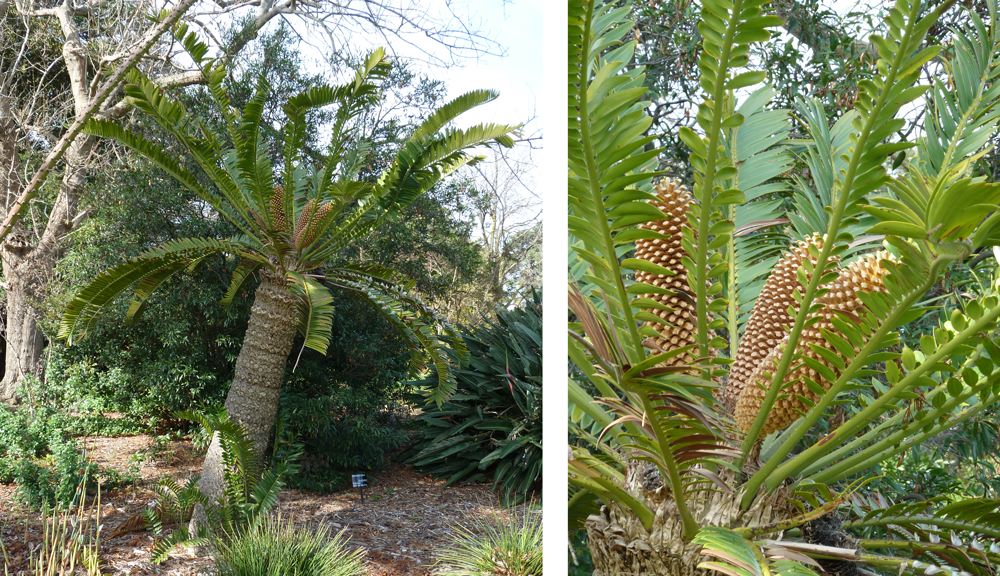
A large cycad at a public garden in Melbourne, Australia. Photograph by Jonathan R. Hendricks.
Compare ↑↓
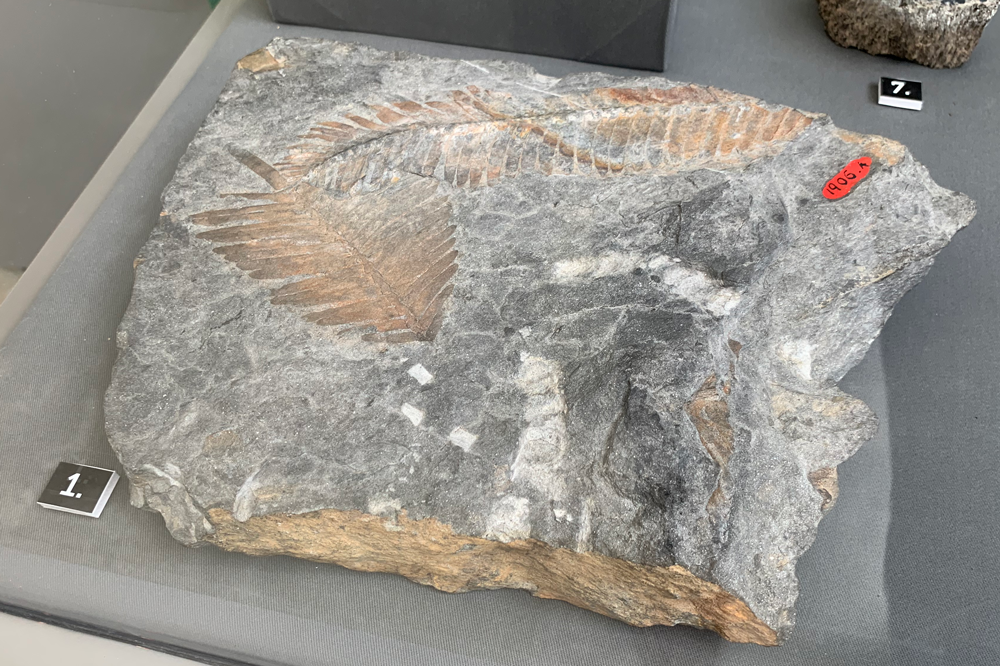
The fossil cycad Zamites gigas from the Jurassic of England.

Ginkgos evolved alongside ferns and cycads in the time before flowering plants. They are first found in fossils from the Early Jurassic, and have existed virtually unchanged since that time. During the Mesozoic, Ginkgo diversity was much higher than it is today, and declined to only two species by the end of the Cretaceous. The species we know today, Ginkgo biloba, appeared around 50 million years ago during the Paleocene. The tree’s wide distribution, and ability to live in disturbed environments likely contributed to its survival.
Although they appear to have fruits like flowering plants, the seeds of the gingko are simply encased in a fleshy shell. Ginkgos are thought to have evolved from seed ferns.
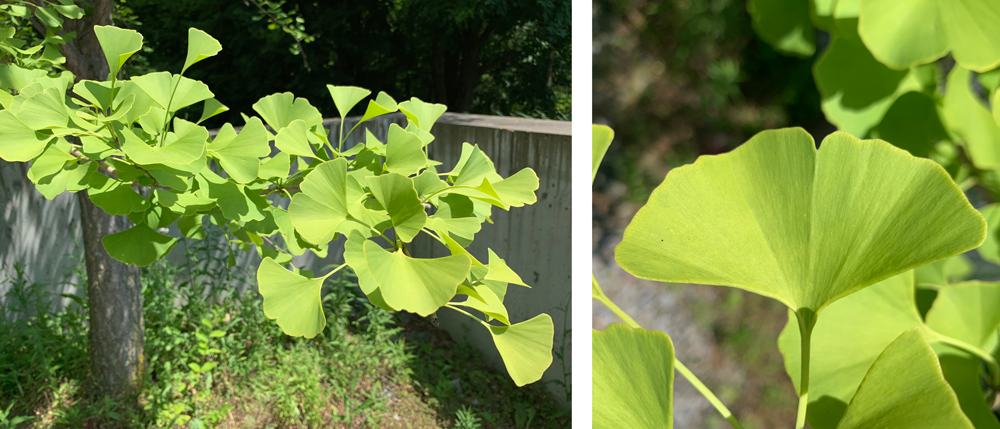
A Ginkgo biloba tree growing behind the Museum of the Earth, Ithaca, New York. Photograph by Jonathan R. Hendricks.
Fossil leaves of Ginkgo huttoni from the Jurassic of England. Specimen is from the Cornell University Paleobotanical Collection (CUPC), Ithaca, New York. Length of specimen is approximately 16.5 cm.
Lost & Found
At the end of the Pliocene, about 3 million years ago, ginkgos disappeared worldwide. The species survived only in central China, where it was cultivated for millennia by Chinese monks. Due to its status as a religious symbol, the tree was also introduced to Korea and Japan. Some planted trees at temples and shrines are known to be over 1500 years old. Without this cultivation, it is possible the ginkgo would have gone extinct.
Europeans first became aware of the ginkgo tree in 1690, when German botanist Engelbert Kaempfer encountered it in a Japanese temple garden. Today, the ginkgo is planted worldwide as an ornamental plant, and it thrives in urban environments.

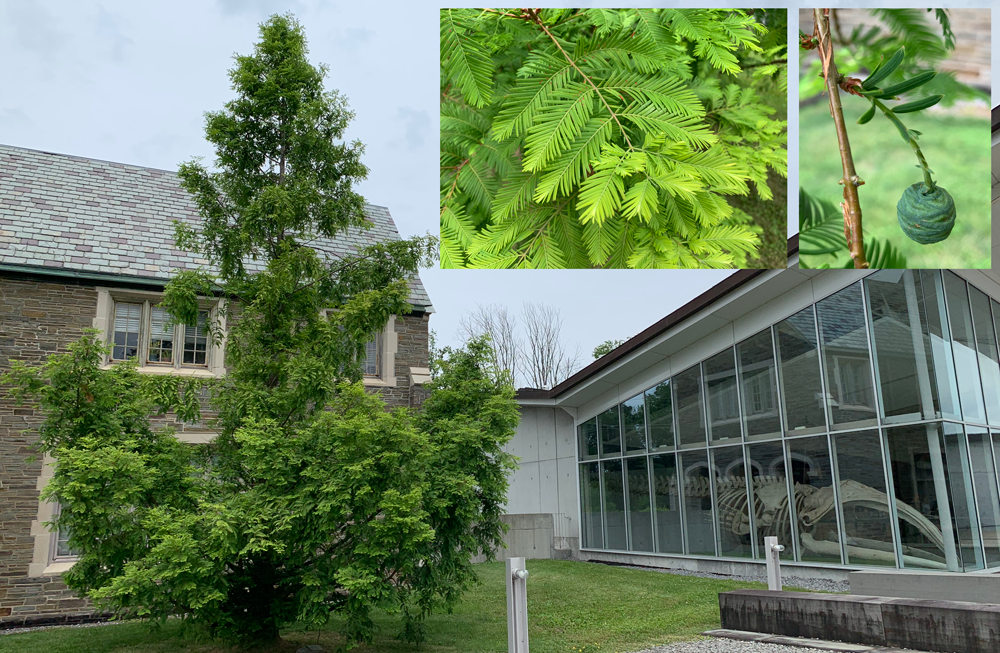
The living fossil "Dawn Redwood" tree (Metasequoia glyptostroboides) growing next to the Museum of the Earth in Ithaca, New York (this species is native to Hubei province in China). Inset images show leaves (left) and a cone (right). Compare these feature with the fossil specimens below. Photographs by Jonathan R. Hendricks.
Fossil leaves of the Dawn Redwood Metasequoia occidentalis from the Miocene of Idaho, preserved as carbonizations. Specimen is from the Cornell University Paleobotanical Collection (CUPC), Ithaca, New York. Length of specimen is approximately 16 cm.
Fossil cones of the Dawn Redwood Metasequoia occidentalis from the Eocene of Canada. Specimen is from the Cornell Unversity Paleobotanical Collection (CUPC), Ithaca, New York. Length of specimen is approximately 11.5 cm.
Contents: Introduction | Microbialites | Plants | Echinoderms | Fishes | Reptiles | Opossum | Brachiopods | Mollusks | Horseshoe Crabs | Insects & Arachnids



